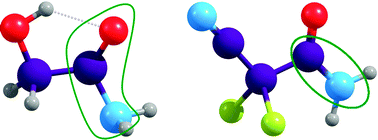Excision of CN− and OCN− from acetamide and some amide derivatives triggered by low energy electrons
Abstract
Low energy

* Corresponding authors
a Institut für Chemie und Biochemie – Physikalische und Theoretische Chemie, Freie Universität Berlin, Takustrasse 3, Berlin, Germany
b
Department of Chemistry, University of Podlasie, 3 Maja 54, Siedlce, Poland
E-mail:
kopyra@ap.siedlce.pl
c Department of Experimental Physics, Comenius University, Mlynska dolina F2, Bratislava, Slovak Republic
Low energy

 Please wait while we load your content...
Something went wrong. Try again?
Please wait while we load your content...
Something went wrong. Try again?
C. Koenig-Lehmann, J. Kopyra, I. Dąbkowska, J. Kočišek and E. Illenberger, Phys. Chem. Chem. Phys., 2008, 10, 6954 DOI: 10.1039/B812130C
To request permission to reproduce material from this article, please go to the Copyright Clearance Center request page.
If you are an author contributing to an RSC publication, you do not need to request permission provided correct acknowledgement is given.
If you are the author of this article, you do not need to request permission to reproduce figures and diagrams provided correct acknowledgement is given. If you want to reproduce the whole article in a third-party publication (excluding your thesis/dissertation for which permission is not required) please go to the Copyright Clearance Center request page.
Read more about how to correctly acknowledge RSC content.
 Fetching data from CrossRef.
Fetching data from CrossRef.
This may take some time to load.
Loading related content
